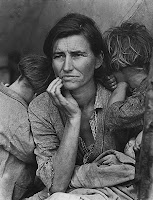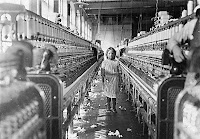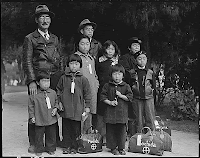A Thousand Words - Storytelling and Editing
A picture is worth a thousand words, as the popular saying goes. The
poetry of that statement belies the underlying truth of just how
powerful images can be. A picture can show a view of reality, but the
objectivity of that reality can be profoundly affected by how that
picture is framed, how an individual's eye travels across the image,
and how that image is interpreted by a viewer's own point of view and
life experience. How an image is composed, read and interpreted can
give that image the power to inspire and arouse great passion and
sometimes great change.
I wanted to develop a lesson for my ROP Video class at I-Poly H.S. that would challenge my students to 'read' a picture and to really think about how they use, and often misuse, editing tools such as transitions and effects.
First, I set up a series of photo buckets with my Picasa account containing


After a short lecture and demo on the grammar of editing transitions and a screening of segments of some Ken Burns documentaries. There is a nice clip on YouTube with Ken Burns explaining how he 'gets into a photograph' and the origin of the famous Ken Burns Effect on iMovie that I used as part of the background lesson.
I assigned the students to make a 90 second photostory with photographs from folders that corresponded to their last name. I asked them to look at each photograph for a minute and develop a point of view and a story from 6 of the 10 images provided. Then storyboard out the narrative showing how the camera would pan and scan the larger image. My goal was to get them to narrate a story, visually.
In addition to using the editing tools, they also composed their own music with Garage Band. The students seemed to get a lot out of the project, and as usually the case with good project-based assignments, I found them doing a fair amount of independent research about their photographs. Research that went well beyond what I was looking to teach them about making good editing decisions.
Here are some nice examples of completed "Thousand Words" projects:
Anne R.'s take on the the Internment of Japanese Americans during World War 2 from Dorthea Lange's photographs.
Karissa N. was moved by Lewis Hine's images of child labor in America during the Industrial Revolution.
I also did the project with the students...here's mine.
Looking at the results, ultimately I think this approach was far more interesting for everyone than a dry tutorial on effects and transitions....not that there is anything wrong with that. :)
poetry of that statement belies the underlying truth of just how
powerful images can be. A picture can show a view of reality, but the
objectivity of that reality can be profoundly affected by how that
picture is framed, how an individual's eye travels across the image,
and how that image is interpreted by a viewer's own point of view and
life experience. How an image is composed, read and interpreted can
give that image the power to inspire and arouse great passion and
sometimes great change.
I wanted to develop a lesson for my ROP Video class at I-Poly H.S. that would challenge my students to 'read' a picture and to really think about how they use, and often misuse, editing tools such as transitions and effects.
First, I set up a series of photo buckets with my Picasa account containing
some historic photographs by Dorthea Lang and Lewis Hine from the Library of Congress' collection. You can see all the photos here, here and here. Pretty powerful stuff!


After a short lecture and demo on the grammar of editing transitions and a screening of segments of some Ken Burns documentaries. There is a nice clip on YouTube with Ken Burns explaining how he 'gets into a photograph' and the origin of the famous Ken Burns Effect on iMovie that I used as part of the background lesson.
I assigned the students to make a 90 second photostory with photographs from folders that corresponded to their last name. I asked them to look at each photograph for a minute and develop a point of view and a story from 6 of the 10 images provided. Then storyboard out the narrative showing how the camera would pan and scan the larger image. My goal was to get them to narrate a story, visually.
In addition to using the editing tools, they also composed their own music with Garage Band. The students seemed to get a lot out of the project, and as usually the case with good project-based assignments, I found them doing a fair amount of independent research about their photographs. Research that went well beyond what I was looking to teach them about making good editing decisions.
Here are some nice examples of completed "Thousand Words" projects:
Anne R.'s take on the the Internment of Japanese Americans during World War 2 from Dorthea Lange's photographs.
Karissa N. was moved by Lewis Hine's images of child labor in America during the Industrial Revolution.
I also did the project with the students...here's mine.
Looking at the results, ultimately I think this approach was far more interesting for everyone than a dry tutorial on effects and transitions....not that there is anything wrong with that. :)



Comments
Very interesting stuff.
www.morningsonmaplestreet.com/lewishine.html
~Crista